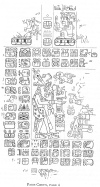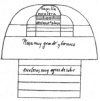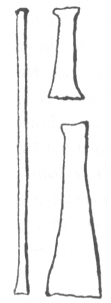
Sacred Texts Native American Maya Index Previous Next
Buy this Book at Amazon.com

Yucatan Before and After the Conquest, by Diego de Landa, tr. William Gates, [1937], at sacred-texts.com

Click to enlarge
PARIS CODEX, PAGE 6
If the number, grandeur and beauty of its buildings were to count toward the attainment of renown and reputation in the same way as gold, silver and riches have done for other parts of the Indies, Yucatan would have become as famous as Peru and New Spain have become, so many, in so many places, and so well built of stone are they, it is a marvel; the buildings themselves, and their number, are the most outstanding thing that has been discovered in the Indies.
Because this country, a good land as it is, is not today as it seems to have been in the time of prosperity when so many great edifices were erected with no native supply of metals for the work, I shall put here the reasons I have heard given by those who have seen these works. These are that they must have been the subjects of princes who wished to keep them occupied and therefore set them to these tasks; or else that they were so devoted to their idols that these temples were built by community work; or else that since the settlements were changed and thus new temples and sanctuaries were needed, as well as houses for the use of their lords, these being always constructed of wood and thatch; or again, the reason lay in the ample supply in the land of stone, lime and a certain white earth excellent for building use, so that it would seem an imaginary tale, save to those who have seen them.
It may be that this country holds a secret that up to the present has not been revealed, or which the natives of today cannot tell. To say that other nations compelled these people to such building, is not the answer, because of the evidences that they were built by the Indians themselves; this is bared to view in one out of the many and great buildings that exist, where on the walls of the bastions there still remain figures of men naked save for the long girdles over the loins called in their language ex, together with other apparel the Indians of today still wear, worked in very hard cement.
While I was living there, in a building we were demolishing there was found a large jar with three handles, adorned with figures applied on the outside; within, among the ashes of a cremated body, we found three counters of fine stone, such as the Indians today use as money, all showing the people were Indians. It is clear that if such they were, they were of higher grade than those of today, and greater in bodies and strength. This shows more clearly here in Izamal than elsewhere, there being here, as I say, today on the bastions figures in semi-relief, made of cement, and of men of great height. The same is true of the extremities of the arms and legs of the man whose ashes we found in the jar I have referred to; these also were very
thick, and their burning a marvel. We see the same thing on the steps of the buildings, here only in Izamal and Mérida, of a good two palms in height.
Here in Izamal is a building, among the others, of a startling height and beauty, as is seen in this sketch and its explanation. * It has twenty steps, each more than two palms in height and in
 Click to enlarge |
From this plaza there rises another stairway like the first, but not so long nor with so many steps, again with an encircling wall. Above these steps there is another fine small platform, on which, close to the surrounding wall, is a very high mound with steps facing the south like the other great stairs, and on top of this a beautiful finely worked chapel of stone. I went to the top of this chapel, and Yucatan being a flat country I could see as far as the eye could reach, an amazing distance, as far as the sea. There were eleven or twelve of these buildings at Izamal, this being the largest, and all near together. There is no memory of the builders, who seem to have been the first inhabitants. It is eight leagues from the sea, in a beautiful site, good country and district, and so in 1549, with some importunity, we had the Indians build a house for St. Anthony on one of these structures. There and all around great benefit has come in its Christianity; so that two good communities have been established in this place, distinct from each other.
The second of the chief ancient structures, such that there is no record of their builders, are those at Tiho, thirteen leagues from those at Izamal, and like them eight leagues from the sea; and there are traces of there having been a fine paved road from one to the other. The Spaniards established a city here, and called it Mérida, from the strangeness and grandeur of the buildings; the chief one of which I shall show here as well as I can, as I did that at Izamal, that it may be seen what it was like.
This is the sketch I have drawn; to understand it, it must be noted that it is a squared site of great size, more than two runs of a horse. † On the east
front the stairway begins at the ground level, with seven steps as high as those at Izamal; on the other three sides, the south, west and north, there runs a very broad strong wall. On top of this first mass, all squared and of dry stone, and flat, there starts again on the east side another stairway, 28 to 30 feet further in than the other stairway, as I judge, and with steps equally large. On the north and south, but not on the west, it is again set back the same distance, with two strong walls reaching the height of the stairway, and continuing until they meet those of the west face, forming a great mass of dry stone in the center, built by hand, of an amazing height and greatness.
On the East, stairway, platform of more than 30 feet; then more stairs. At the South, a long apartment, divided; at the North, another, same. At the West another range broken by an arcade, and with a chapel, and patios in front and behind. In the center a great patio, between the two ranges, each made up of rooms, broken by arcades.
On the level top are buildings in the following manner: six feet back of the stairway is a long range not reaching to the ends, of very tine stonework, made up of cells on each side, twelve feet long by eight wide; the doors of these have no sign of facings or hinges for closing, but are flat and of stone elaborately worked, the whole marvelously built, and the tops of the doorways formed of single large stones. In the middle is a passageway like the arch of a bridge; above the doors of the cells there projected a relief of worked stone the whole length of the structure. Above this was a line of small pillars, half inset in the wall with the outer part rounded, and reaching to the level of the cell roofs. Above these there was another relief extending the whole length of the range; and then came the terrace, finished with a very hard stucco made with the water from the bark of a certain tree.
On the north was another range with cells, the same as the above, but the whole only half the length. On the west was another line of the cells, pierced at the fourth or fifth by an arcade going clear through the whole, like the one in the east front; then a round, rather tall building; then another arcade, and the rest cells like the others. This range crosses the whole court not quite in the center, thus making two courts, one to the back at the west, the other on the east, surrounded by four ranges as described. The last of these ranges however, to the south, is quite different. This consists of two sections, arched along the front like the rest, the front being a corridor of very thick pillars topped by very beautifully worked single stones. In the middle is a wall against which comes the arch of the two rooms, with two passageways from one to the other; the whole is thus enclosed above and serves as a retreat.
About two good stone-throws distant from this edifice is another very high and beautiful court, containing three finely ornamented pyramids, on top of them chapels, arched in the fashion they were used to employ. Quite a distance away was a pyramid, so large and beautiful that even after it had been used to build a large part of the city they founded around it, I cannot say that it shows any signs of coming to an end.
The first of the above structures, with the four ranges, was given to us by the admiral Montejo, all covered with heavy trees; we cleared it, and there built us a proper monastery all of stone, and a fine church which we called after the Mother of God. There was so much stone that after leaving the southern range, and part of the others, we gave much stone to the Spaniards for their houses, particularly for their doors and windows; such was the abundance.
The buildings at Tikoch are not so many nor so sumptuous as many of these others, although they were good and noteworthy; I only mention them here on account of the great population there must have been, as I have before had to relate; thus I leave this here. These buildings are three leagues from Izamal toward the east, and seven leagues from Chichén Itzá.
Chichén Itzá *, then, is a fine site, ten leagues from Izamal and eleven from Valladolid. Here as the old men of the Indians say, there reigned three lords, brothers who (as they recall to have been told them by their ancestors) came from the land to the west, and gathered in these places a great settlement or communities and people whom they ruled for some years in great peace, and with justice. They greatly honored their god, and thus erected many magnificent buildings; especially one, the greatest, whose design I shall give here as I sketched it by standing on it, the better to explain it.
They say that these lords lived as celibates and with great propriety, being highly esteemed and obeyed by all while they so lived. In the course of time one of them failed, so that he died; although the Indians say that he went away by the port of Bacalar, out of the country. However that was, his absence resulted in such a lowering among those who ruled after him that partisan dissensions entered the realm; they lived dissolutely and without restraint, to such a degree that the people came to hate them so greatly that they killed them, overthrew the régime, and abandoned the site. The buildings and the sites, both beautiful, and only ten leagues from the sea, with fertile fields and districts all about, were deserted. The following is the plan of the principal edifice:
This structure has four stairways looking to the four directions of the world, and 33 feet wide, with 91 steps to each that are killing to climb. The steps have the same rise and width as we give to ours. Each stairway has two low ramps level with the steps, two feet broad and of fine stonework, like all the rest of the structure. The structure is without corners, because starting from the base it narrows in, as shown, away from the ramps of the stairs, with round blocks rising by stages in a very graceful manner.
When I saw it there was at the foot of each side of the stairways the fierce mouth of a serpent, curiously worked from a single stone. When the stairways thus reach the summit, there is a small flat top, on which was a building with four rooms, each having a door in the middle, and arched above. The
 |
Around this structure there were, and still today are, many others, well built and large; all the ground about them was paved, traces being still visible, so strong was the cement of which they were made. In front of the north stairway, at some distance, there were two small theatres of masonry, with four staircases, and paved on top with stones, on which they presented plays and comedies to divert the people.
From the court in front of these theatres
 |
This well is seven long fathoms deep to the surface of the water, more than a hundred feet wide, round, of natural rock marvelously smooth down to the water. The water looks green, caused as I think by the trees that surround it; it is very deep. At the top, near the mouth, is a small building where I found idols made in honor of all the principal buildings in the land, like the Pantheon at Rome. I do not know whether this is an ancient invention, or one of the modern ones, that in coming with offerings to the well, they might come into the presence of their idols. I found sculptured lions, vases and other things, so that I do not understand how anyone can say that these people had no tools. I also found two immense statues of men, carved of a single stone, nude save for the waist-covering the Indians use. The heads were peculiar, with rings such as the Indians use in their ears, and a collar that rested in a depression made in the chest to receive it, and wherewith the figure was complete.
86:* In front, "steps very hard to climb." Then a very large and beautiful plaza; another plaza, and then steps with a chapel on top.
86:† p. 87 An early distance reckoning for as far as a horse will run without taking breath; roughly 1,200 feet.
88:* p. 89 So much is available on Chichén Itzá, thanks to the work of the Mexican government under its local director, Señor Eduardo Martinez, and of the Carnegie Institution of Washington, that we have only attempted to confirm Landa's statements by a few instances of the things he refers to. For those things illustrated on the next page, from among the objects dredged from the cenote, we owe the courtesy of Mr. Willard; they show a repoussé gold plate, and three copper cutting tools.